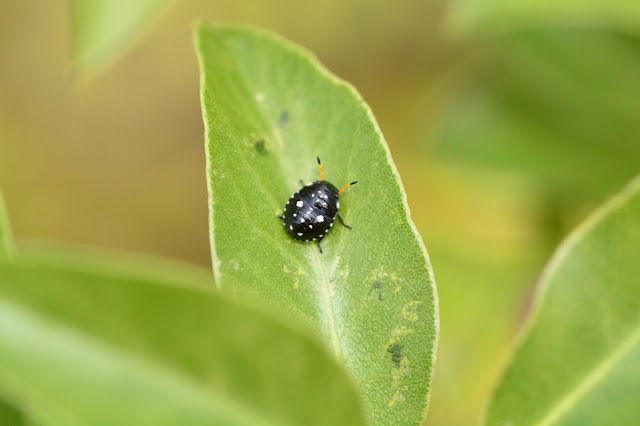 |
| 3rd or 4th instar nymph of Pittosporum shield bug among the seeds in the pod of Karo plant. |
 |
| Adult Pittosporum shield bug |
 |
| Nymph of Pittosporum Shield Bug |
 |
| Early instar nymph of pittosporum shield bug |
Class: Insecta
Order: Hemiptera
Suborder: Heteroptera
Infraorder: Pentamomorpha
Superfamily: Pentatomoidea
Family: Pentatomidae
Genus: Pseudapines
Pseudapines geminata
The nymphs of Pittosporum Shield Bug: The early instar nymphs are about 2 to 3 mm in size and circular in shape. The black body has symmetrical white spots. They lack wings, as any nymphs of hemiptera. The antennae are orange in colour, the last segment is black. They are shy and hide behind the leaves when disturbed.
The adults of the Pittosporum Shield Bug: The adults have wings. The shield shaped body is dull black with white spots. The outer edges of wings, thorax and the abdomen are orange in colour. The first two segments of the antennae are orange in colour, followed by alternating black and orange segments.
The relationship between the Pittosporum plant and the shield bug is that of symbiosis based on mimicry complex. The seed pods are three valved capsules which split to expose black sticky seeds with in. The nymphs and the adults of Pittosporum Shield Bug are black in colour with white spots which make them look very similar, almost indistinguishable from the seeds. The seeds serve as food for the shield bug. The shield bugs use their piercing mouth parts to suck the nutrients through the hard outer layer of the seed. When birds and other insects predate on the shield bug, they also carry the sticky seeds with them which helps in dispersion of the seed and propagation of the plant. The shield bugs protect themselves by releasing an alkaloid cocktail which can cause an allergic reaction to the predators (and to humans who handle the insect). These shield bugs are widely regarded as pests of this garden decorative plant, which itself is not native to the region.
reference: Guide To Wildlife of Perth And South West

No comments:
Post a Comment
Note: only a member of this blog may post a comment.